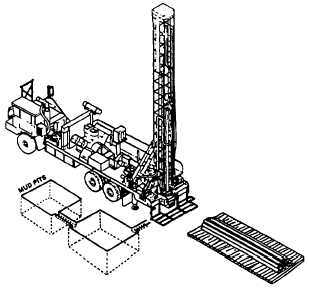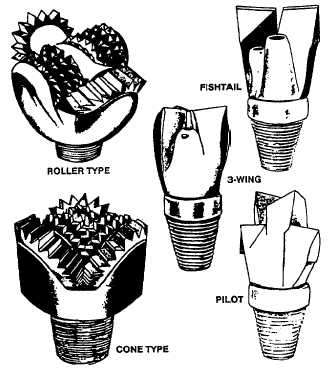plastering action of the fluid spiraling against the wall
of the well, prevent the wall from caving-in. The
consistency of the mud must permit the cuttings to be
held in suspension in the hole, yet permit them to settle
out in the surface pits. Although some local clays will
mix to an acceptable consistency, many do not. A
commercially prepared clay, such as Bentonite, must be
added to improve the density of the mud.
Kelly-Drive Rotary Drilling Operations
In well drilling, details of setting up the rig will vary,
depending on the rig used. Well drilling rigs can be
skid-mounted, trailer-mounted, truck-mounted, or even
self-propelled. In any case, it is necessary that the rig is
level and cribbed with dunnage before operations begin.
Keeping your rig level helps to keep the hole straight
during the drilling operation.
While the rig is being leveled, part of the crew can
excavate the mud pits (fig. 9-10). The size of the pit
depends on the water supply, depth of drilling, and the
type of material drilled. A fluid return ditch should be
dug from the drilled hole to the settling pit and from the
settling pit to the main pit. The ditches enter and leave
the settling pit in such a reamer that the flow of fluid is
reversed and causes the cuttings to settle, thus keeping
them from flowing into the main pit. The pits are lined
and sealed with drilling mud and then water is added.
Once the mud pits are full of water, the drilling mud can
be added and mixed to the right viscosity with the
mixing hose. The suction-hose screen is then placed in
the main pit at the opposite end of the return ditch. The
suction hose is submerged at all times but does not lie
on the bottom.
Keep the circulating fluid as clean and free from
abrasives as possible to protect the pump parts. The
settling pit should be cleaned when 75% full of cuttings
so that cuttings will not be placed in circulation. The pit
is cleaned when the rig is stopped for a drill pipe change,
or drill bit cleaning.
A water supply is essential when drilling wells by
the rotary method. There is no set rule as to the amount
of water required to drill any one hole. In some cases,
where the formations are compact, 3 to 4 gallons of
water per foot of hole drilled is sufficient. In other cases
where formations are loose and extremely porous, a
large supply of water is required. For ordinary purposes,
750 to 1,000 gallons of water per 8-hour shift is needed.
Skid-mounted and canvas tanks are usually apart of the
drilling outfit.
Figure 9-10.-Mud pits.
Even holes spaced only a short distance apart and
in the same soil formation may require different drilling
techniques. The drill supervisor must be capable of
selecting the best bit for penetrating a particular for-
mation. Some examples of rotary drilling bits are shown
in figure 9-11. Either the roller or the cone type of rock
bit can be used to penetrate moderately hard to hard
formations; a fishtail, three way, or pilot bit can be used
to penetrate soft formations and overburden material.
Figure 9-11.-Drill bits.
9-9




